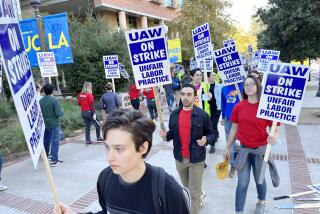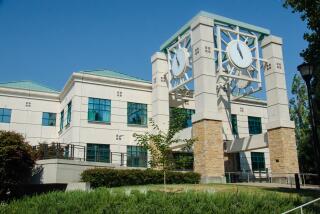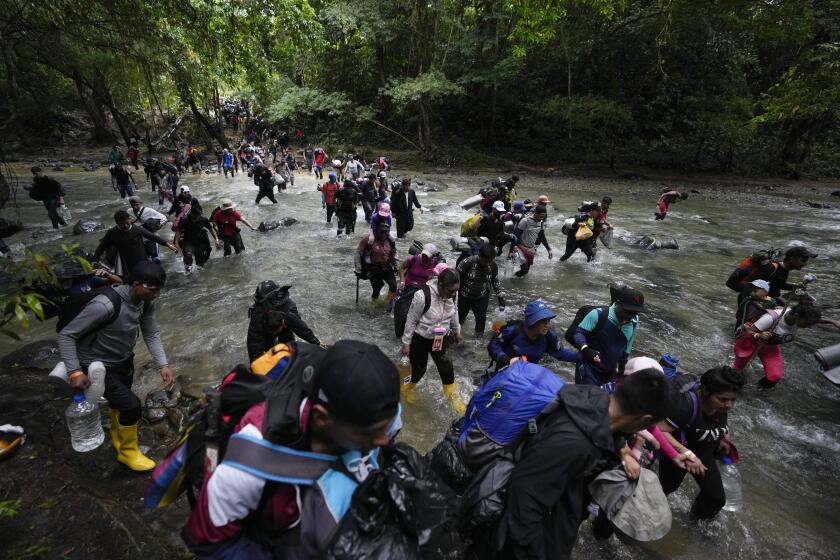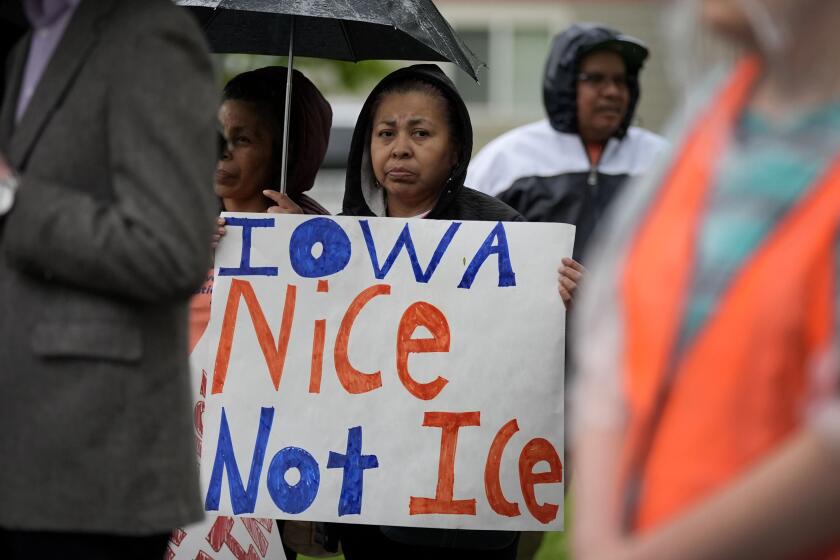Immigrants See an Empowered Life as Citizens : Naturalization: Green-card residents, some here for decades, are now taking steps to fully join the mainstream. Fearful of the future, they seek acceptance and influence.
Twenty-four years ago, Cecilia Maciel left her 13 brothers and sisters in the tiny rancho of San Jose de Gracia in Michoacan and came to Orange County to escape a poverty so stark she didn’t own a pair of shoes until she was a teen-ager.
She arrived hesitant, illiterate and full of hope, and by 1972 she was manufacturing plastic hoses on a Costa Mesa assembly line, a job she held for more than a decade. By 1976 her green card was tucked snugly in her wallet.
Now, after all these years, the 46-year-old Santa Ana resident has joined a growing number of the city’s longtime immigrants who are applying for U.S. citizenship, eager to cement their status as hard-working citizens and contribute to political debate.
“What do we lack, those of us who aren’t citizens? Education,” said Maciel, a community activist who works with a church-based organization. “I want to promote a program to explain to people why we should become citizens and explain it well: We are the ones with the power, not the President.”
Appalled by the tenor of anti-immigrant sentiment and worried their rights will be whittled away, legal immigrants are signing up for citizenship classes in record numbers to take what they hope is the final step toward mainstream acceptance.
They knock daily on the doors of Santa Ana’s Delhi Community Center for immigration consultations. They approach their priests to inquire about the application process. Many pack night classes to study the Constitution and the Pilgrims, and they memorize a litany of U.S. government trivia in an effort to pass the written civics test that marks one hurdle of naturalization.
The Immigration and Naturalization Service has only just begun to break out separate statistics for Orange County, but officials say they have noted a dramatic rise in citizenship applications throughout the seven-county region of the Los Angeles district since last fall.
Local agencies offering the INS-approved citizenship test countywide say much of the recent interest has come from people in Orange County’s Vietnamese and Latino communities. In the Santa Ana area, most are of Mexican descent.
“Citizenship is becoming part of the daily banter among Latinos in my parish,” said Msgr. Jaime Soto, Hispanic vicar for the Diocese of Orange. “I either have people asking me questions about it or telling me about how their test went.”
Added Delhi Community Center Executive Director Irene Martinez:
“People who have been here for 20 or 30 years who have never considered it are suddenly showing up at our doors and saying, ‘I want to become a citizen.’ People are very conscious of the political climate and the comments being made.”
To respond, Catholic Charities in Santa Ana is launching its first citizenship classes next week. And Rancho Santiago College is setting up the county’s first community college-based citizenship center, which will offer full application services by September, complete with fingerprinting and photographing, said Kenny Gomez, who heads the newly formed center and is community outreach specialist for the college’s continuing education division.
The Diocese of Orange held its first volunteer training session last week in conjunction with Catholic Charities to begin offering combined English and citizenship classes out of Orange County churches as soon as possible, Soto said. The parishes also plan to offer educational citizenship fairs.
With the wave of citizenship-seekers comes a new hope for a political presence in the Spanish-speaking community.
“With so much of the anti-immigrant sentiment going around the county, it’s underlining the need for the immigrant communities to assert themselves in the political forum in much the same way that they are doing in the economic arena--in a significant way,” Soto said.
“This may not have a direct impact on the elections for November, but our hope is as a church to be able to awaken an appreciation for what the immigrant communities are doing and can do for the state of California.”
Social services workers cite several reasons for the increased interest in citizenship. Those who received their green cards before 1978, like Maciel, must swap the cards for new ones in September at a cost of $75 and pay to renew them every 10 years. Rather than do that, immigration activists and even INS officials are encouraging them to pay just $20 more to complete a citizenship application.
And many of the immigrants who were legalized during the amnesty program of the late 1980s are just now becoming eligible for citizenship.
“We want to integrate ourselves more into this country,” Ofelia Ibarra, 49, of Santa Ana said as she sat with her husband in a Rancho Santiago College citizenship class. “For me, it’s very important to have rights, to have more freedom to work, and to learn more about this country.”
Her husband, Javier Ibarra, said the United States has offered him an opportunity to work as a shoemaker and raise five daughters since he and Ofelia arrived from Mexico in 1976. The couple became legal residents just five years ago under the amnesty program and wasted no time in seeking citizenship.
“I have received a lot from this country, and for that reason I love this country,” said Javier Ibarra, 52.
Many of the region’s new applicants say they are propelled by a more insidious factor: the growing anti-immigrant climate sweeping the state.
“This country is supposed to be one of the most democratic in the world, but lately these politicians are all going back, back in time, like crabs,” said Plutarco Cedeno, 50, of Santa Ana.
Cedeno came to the United States legally from Ecuador 30 years ago and said he never considered citizenship until the rhetoric against Latino immigrants became increasingly sour a year ago.
“There’s more and more discrimination,” Cedeno said, as his citizenship class practiced filling out their citizenship applications and pronouncing words like “Plymouth” and “Mayflower.”
Consuelo Chavez also never felt the urge to become a citizen before the daily gibes of the media turned to anti-immigrant legislation and the Save Our State initiative. That measure will appear on the November ballot and could deny health and education benefits to illegal immigrants and their children if it becomes law.
Chavez has lived in the neatly kept Delhi neighborhood for 30 years, raised her family there and was granted legal residency more than 20 years ago.
“We’re worried we will lose our Social Security benefits,” she said. “For this, I want to fix my status, to become a citizen.”
Others are worried that non-citizens--even though they are legally in the United States--may lose their access to financial aid for college. And some are just incensed that after all their years here, they are increasingly being viewed with suspicious eyes.
“Recently a parishioner came to me very frustrated. He’s been a permanent resident for many years. He went to go renew his driver’s license and they gave him a temporary one because they wanted to do a background search to see if his green card was valid,” Msgr. Soto said.
“He was so frustrated that his integrity was called into question, his first question to me was: ‘If I become a citizen, will they stop doing that to me?”’
How Well Would You Do?
The written portion of the citizenship test covers civics and history. Applicants take classes to study 100 possible questions, 20 of which appear on the exam. Twelve out of 20 is a passing score. A sampling:
Q: Who elects the President of the United States?
A: The Electoral College
Q: How many changes or amendments are there to the Constitution?
A: 26
Q: What are the duties of the Supreme Court?
A: To interpret laws
Q: How many representatives are there in Congress?
A: 435
Q: Who was the main writer of the Declaration of Independence?
A: Thomas Jefferson
Q: Who was Martin Luther King Jr.?
A: A civil rights leader
WHERE TO GET HELP
Some of the agencies offering assistance to those interested in applying for U.S. citizenship:
* Hermandad Mexicana Nacional. 825 N. Broadway, Santa Ana. (714) 541-0250
Services: INS-approved testing site. Written test administered second Saturday of each month; free citizenship classes held every Tuesday; assistance completing citizenship application, including fingerprinting and photograph, for a nominal fee.
* Delhi Community Center, 542 E. Central Ave., Santa Ana. (714) 549-1317
Services: Free immigration consultation; free citizenship classes held three times a week (classes will resume in September); assistance completing citizenship application, including fingerprinting and photograph, for a nominal fee.
* Rancho Santiago College, Citizenship Center. Centennial Education Center, 2900 W. Edinger Ave., Santa Ana. (714) 564-5060
Services: INS-approved testing site. Written test administered second Saturday of each month; free citizenship classes. Other services will be in operation by early September, including application assistance, fingerprinting and photograph, for a nominal fee.
* Catholic Charities, 1506 Brookhollow Drive, Santa Ana. (714) 662-7500
Services: INS-approved testing site. Written test administered second Saturday of each month; free citizenship classes begin Saturday, July 23 and July 30, and will continue every Saturday if successful; application assistance including fingerprinting, photograph and help preparing for oral exam. Beginning work with Hispanic Ministries of the Diocese of Orange to offer combination English as a Second Language/citizenship classes in local parishes. Will train volunteer teachers.
Source: Rancho Santiago College, U.S. Immigration and Naturalization Service; Researched by LEE ROMNEY / Los Angeles Times
Seeking Citizenship
Applications for U.S. citizenship have increased dramatically at the Los Angeles district office of the Immigration and Naturalization Service, which serves a seven-county region in Southern California. the INS began tracking Orange County separately last month, when the daily average was 51. The daily average number of applications from the seven-county region:
(from October 1993 through June 1994): 545 Source: U.S. Immigration and Naturalization Service; Research by Lee Romney / Los Angeles Times
More to Read
Start your day right
Sign up for Essential California for news, features and recommendations from the L.A. Times and beyond in your inbox six days a week.
You may occasionally receive promotional content from the Los Angeles Times.







